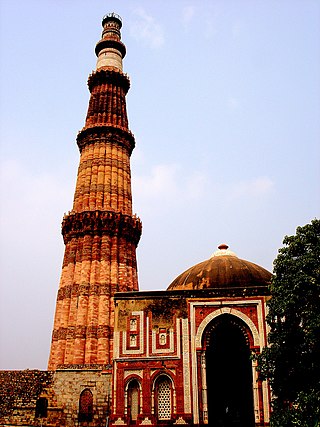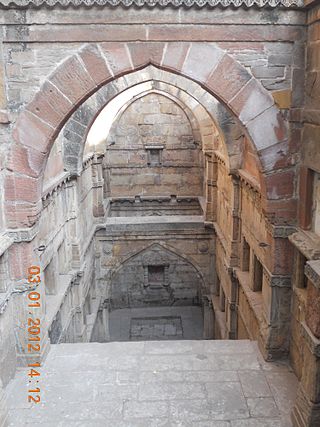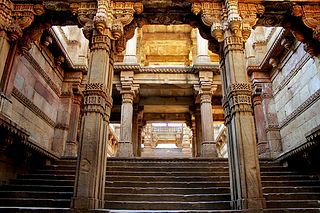
Mehrauli is a neighbourhood in South Delhi, Delhi, India. It represents a constituency in the legislative assembly of Delhi. The area is close to Gurugram and next to Vasant Kunj.

Adalaj is a census town in Gandhinagar district located in the western Indian state of Gujarat. With a population of roughly 12,000 residents within the town limits as of 2011, Adalaj is known for its semi-arid climate and its historic and religious establishments. The town sits in a generally flat area covering about 18 sq. km.
Meham, also spelled Maham, is a small city in Rohtak district of the Indian state of Haryana. It is one of the two sub-divisions in Rohtak district. As a tehsil, it is further divided into two community development blocks, Maham and Lakhan-Majra.

Agrasen Ki Baoli is a 60-meter long and 15-meter wide historical stepwell in New Delhi, India.

Temple tanks are wells or reservoirs built as part of the temple complex near Indian temples. They are called pushkarini, kalyani, kunda, sarovara, tirtha, talab, pukhuri, ambalakkuḷam, etc. in different languages and regions of India. Some tanks are said to cure various diseases and maladies when bathed in. It is possible that these are cultural remnants of structures such as the Great Bath of Mohenjo-daro or Dholavira, which was part of the Indus Valley civilization. Some are stepwells with many steps at the sides.

Rani Ki Vav is a stepwell situated in the town of Patan in Gujarat, India. It is located on the banks of the Saraswati River. Its construction is attributed to Udayamati, the spouse of the 11th-century Chaulukya king Bhima I. Silted over, it was rediscovered in the 1940s and restored in the 1980s by the Archaeological Survey of India. It has been listed as one of the UNESCO World Heritage Sites in India since 2014. This stepwell is designed as an inverted temple highlighting the sanctity of water. It is divided into seven levels of stairs with sculptural panels. These panels have more than 500 principal sculptures and over 1000 minor ones combining religious, secular, and symbolic imagery.

Chand Baori is a stepwell situated in the village of Abhaneri in the Indian state of Rajasthan. It extends approximately 30 m (100 ft) into the ground, making it one of the deepest and largest stepwells in India. It is named after a local ruler of Nikumbh dynasty called Raja Chanda and its construction is dated to the 8th-9th century. It has 3500 steps cascading 13 stories deep into a massive tank at the bottom and has been constructed in an upside-down pyramid-style.

Adalaj Stepwell or Rudabai Stepwell is a stepwell located in the small town of Adalaj, close to Gandhinagar city in the Indian state of Gujarat. It was built in 1498 in the memory of Rana Veer Singh of the Vaghela dynasty.

Rajon ki Baoli also referred as Rajon ki Bain is a famous stepwell in Mehrauli Archaeological Park of Delhi, India.

Dwarka Baoli is a historical stepwell recently discovered in Dwarka Sub City, in south west New Delhi, India. It was constructed for the residents of Loharehri village by the Sultans of the Lodi Dynasty in the early 16th century. Dwarka now stands where the Loharehri village once stood. Located in a barren stretch of land between a residential society and a private school on Azad Hind Fauj Marg, Sector 12, Dwarka, at 28-35-58.95 degree North and 77-02-38.67 degree East. It was hidden by a large group of Peepal trees and covered by a thick undergrowth which seems to have aided in its relative obscurity. It is mentioned in Maulvi Zafar Hasan's 1910 Monuments list which says it was not very deep and had 22 steps. It is under restoration by the State archeological department and work will be taken up by INTACH Delhi Chapter.

Amritavarshini Vav, also known as Panchkuva Stepwell or Katkhuni Vav, is a stepwell near the Panchkuva Darwaja in Ahmedabad, Gujarat, India.

Bai Harir Sultani Stepwell is a 15th century stepwell in Asarwa area 15 km off Ahmedabad, Gujarat, India.

Mata Bhavani's Stepwell or Mata Bhavani ni Vav is a stepwell in Asarwa area of Ahmedabad, Gujarat, India.

Jethabhai's Stepwell or Jethabhai ni Vav, is a stepwell in Isanpur area of Ahmedabad, Gujarat, India. It was situated near sha e Alam and one of the heritage stepwells in Ahmedabad.

Vikramjit Singh Rooprai is an Indian author, educator, and heritage activist. He started his career as a software engineer and later became a digital marketing consultant. He left his full time IT job in 2015, and became an educator, establishing heritage labs in schools and training teachers on how to use history to teach various subjects. His first book Delhi Heritage: Top 10 Baolis, dedicated to the stepwells of Delhi, is published by Niyogi Books.

The Baolis of Mehrauli are four stepwells approached through single stage or three stage steps, located in Mehrauli in Delhi, India, in the Mehrauli Archaeological Park mainlined by the Archaeological Survey of India. These are the Anangtal Baoli, the Gandhak Ki Baoli, and the Rajon Ki Baoli. These were built below the ground level as ground water edifices and were built near shrines in medieval times.
Stepwells are wells in which the water is reached by steps. They are most commonly found in western India especially Gujarat where over 120 such wells are reported. The origin of the stepwell may be traced to reservoirs of the cities of the Indus Valley civilization such as Dholavira and Mohenjo-daro. The stepwells were constructed in the south western region of Gujarat around 600 AD. From there they spread north to Rajasthan and subsequently to north and west India. Construction activities accelerated during the tenth to 13th century during the Chaulukya and Vaghela periods. The construction of these stepwells hit its peak during the 11th to 16th century. The Muslim rulers of the 13th to 16th century did not disrupt the culture that was practiced in these stepwells and encouraged the building of stepwells. The wells lost their significance in the 19th century due to introduction of water pumps and pipe-systems.

Māru-Gurjarat architecture or Solaṅkī style, is the style of West Indian temple architecture that originated in Gujarat and Rajasthan from the 11th to 13th centuries, under the Chaulukya dynasty. Although originating as a regional style in Hindu temple architecture, it became especially popular in Jain temples, and mainly under Jain patronage later spread across India, then later to diaspora communities around the world.

The Shahjahan ki baoli, more commonly known as the Choron ki baoli, is a baoli in Maham, Haryana, India. The structure, which was built during the reign of Emperor Shah Jahan, collects and holds rainwater for use by the nearby town of Maham. While no longer in mainstay use, the baoli has been persevered as a tourist attraction.
The Architecture of Gujarat consists of architecture in the Indian state of Gujarat.
































